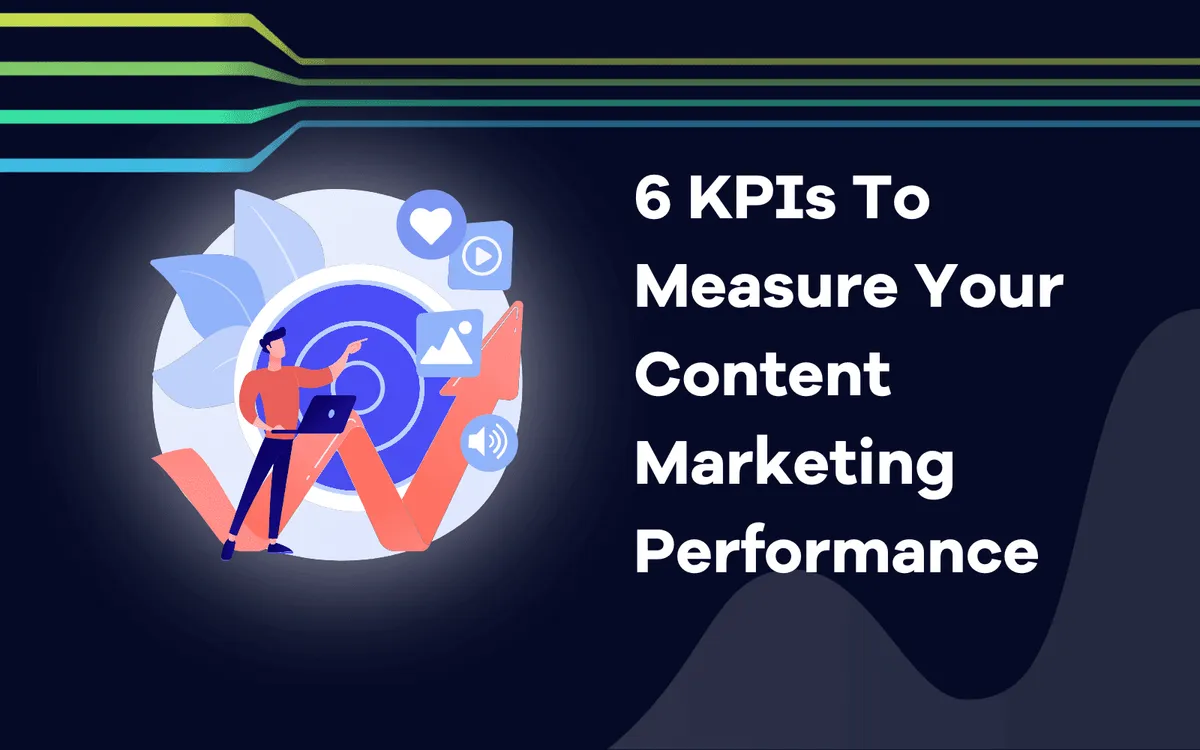
6 KPIs To Measure Your Content Marketing Performance

Jeremy
January 30, 2024
Are your content marketing investments really worth it? Here are 6 KPIs to track the performance of your content marketing efforts.
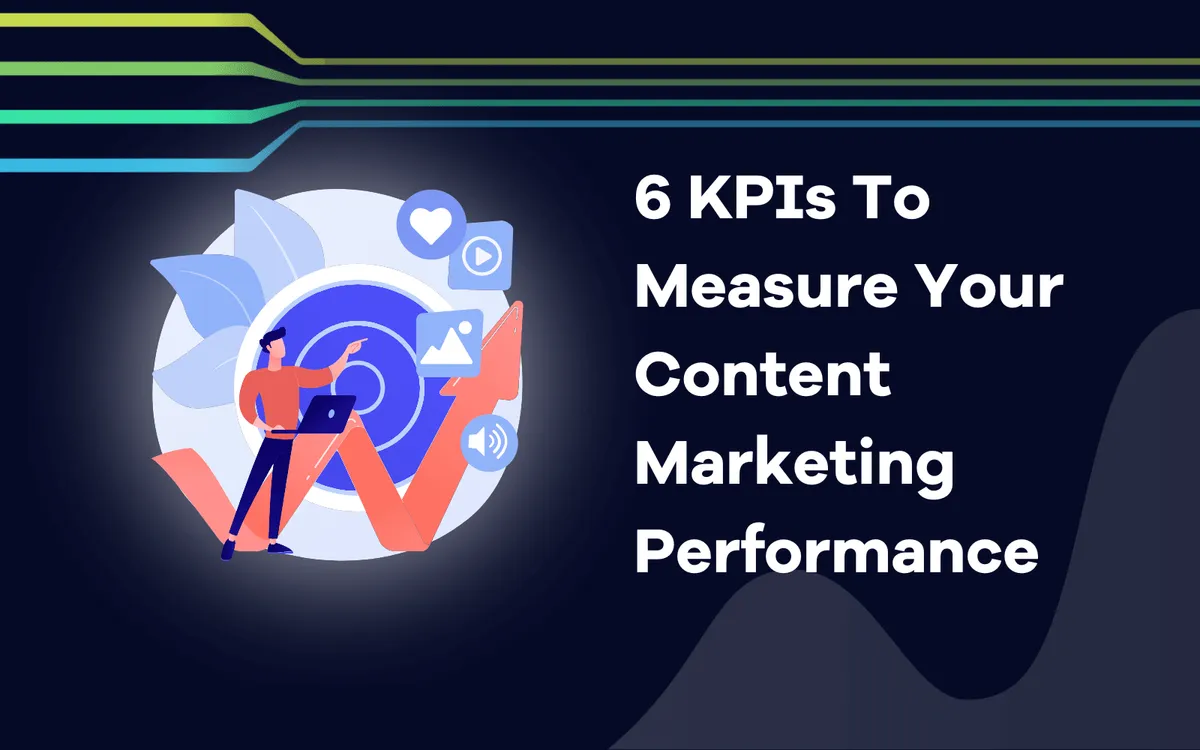
Your content marketing initiatives are the backbone of your business growth. By creating quality, optimized, targeted content, you can push your businesses out before your audiences' eyes, gaining brand awareness, authority, and trust.
But creating content isn’t enough to move the needle. You must also track and analyze certain metrics. Unless you consistently monitor a series of Key Performance Indicators (KPIs), you might waste time, money, and effort on a losing strategy.
By tracking KPIs, you can gauge your overall success or failure as a content marketer. Thanks to KPI analysis, we can determine where we were, where we are, and how far we still have to go.
But what KPIs should you measure to gauge the effectiveness of your content marketing? This article will walk you through several KPIs you need to monitor to run a successful content marketing plan.
How Can You Get Started With Content Marketing?
When we say content marketing, we discuss a marketing plan driven by creating and distributing quality content. This could mean text-based content like blog articles but also pertains to video content, audio content, ebooks, and more.
But you need to begin somewhere, and we recommend creating long-form content as a solid starting point.
Long-form content is a great way to build trust with your audience and cohesively present your brand. When well-made and properly optimized, long-form articles can benefit your audience and build your brand reputation. Long-form content also tends to attract more backlinks.
If you’re looking for inspiration on how to build a successful blog and articles, you can follow the example of Tailor Brands. The company is a one-stop shop for those looking to start a business. It creates long-form content related to business formation and branding.
The brand creates easy-to-read content that still goes in-depth without becoming confusing. These articles answer customers’ most common questions. Its post on the role of a registered agent when forming a business is an excellent example of creating compelling content with the audience in mind.
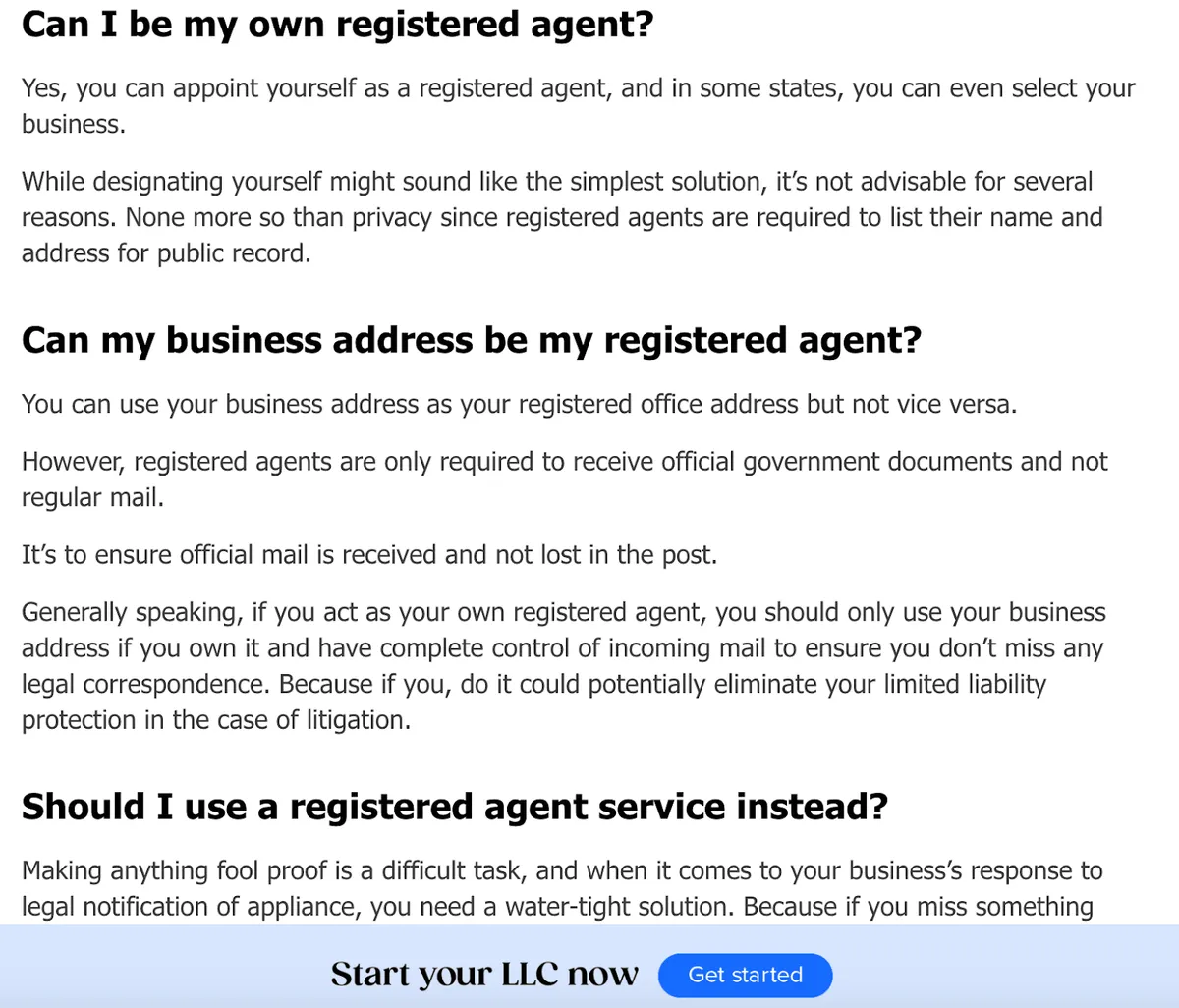
Source: Tailor Brands
Content like the article pictured above can not only inform your audience and answer their burning questions, but it also solidifies you in their hearts and minds as an authority on the subject. That means when they need to turn to a professional for services related to their pain points, you'll be top of mind.
The most effective marketing plans are those that receive cooperation company-wide. Your marketing team can’t horde the content marketing plan. It should be distributed and understood by every team in your company. Using operational analytics, you can move data from various collection points and storage spaces into the hands of your different teams to create more effective workflows and foster a better understanding between teams.
When the other teams in your company understand what you’re trying to accomplish, they can offer support and make your content creation process easier. For example, the sales assistant can reach out to content writers in marketing to let them know the most common pain points and objections they receive when speaking to prospects. The marketing team can then create content around that information and develop a content plan for social media. Using available online tools such as an AI writer to accelerate your blog writing process or a social media post scheduler to organize content will help marketing teams succeed.
How Should You Track Each KPI for Content Marketing?
Before we get into what KPIs you should track, let’s discuss how to track them. For starters, you’re going to need some tools. Something like Google Analytics, for example, would be a great platform for tracking KPIs pertaining the web traffic.
Then you have session replay and heat map tools like DataDog and Hotjar, which can help determine how your audience interacts with each page. Social media marketing tools like Hootsuite can help you watch for changes in likes, comments, followers, and general engagement. You can also use these tools to gauge the effectiveness of each post, including how many people saw your posts (impressions) vs how many interacted with them (clicked or shared).
Regarding your SEO content marketing, tools like SurferSEO and Frase can help optimize your content for SERPs. While these tools are powerful allies in content creation and to have data to analyze, you must first optimize, they don’t offer the analytics you need to track KPIs.
That’s where tools like Ahrefs and SEMRush come into play. These are the frontrunners in the SEO industry and can track the metrics crucial to your SEO strategy.
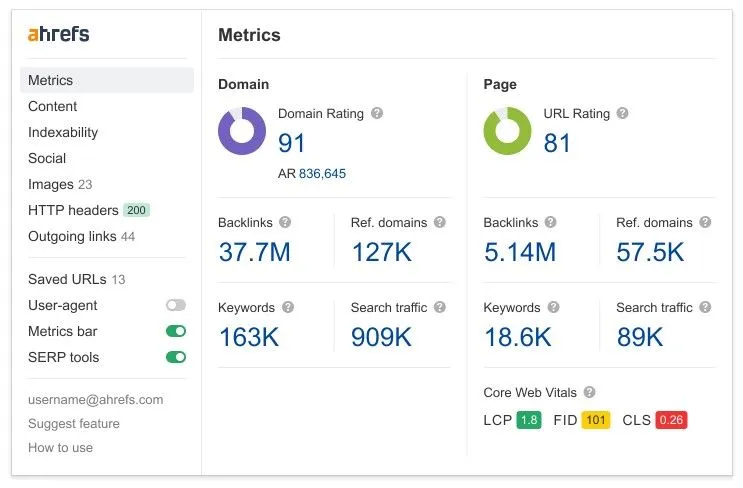
Source: Ahrefs
This will help you identify gaps in your content strategy and opportunities for improvement.
Tools like these offer a wide range of features, including rank trackers, site explorers, and reports on specified KPIs. You can run these reports manually or schedule them to run automatically and have the results emailed to you.
These tools complement Google Analytics 4 to provide the most detailed and accurate information.
Which KPIs Should Content Marketers Track?
Now that you understand the background information, it’s time to start digging into which KPIs you should track.
Bounce Rate
While it’s great to know how many people are coming to your site, it’s equally important to understand what they’re doing and how long they stay.
That’s where our first content marketing KPI, bounce rate, comes into play. Your bounce rate shows the percentage of website visitors who leave after viewing only one page.
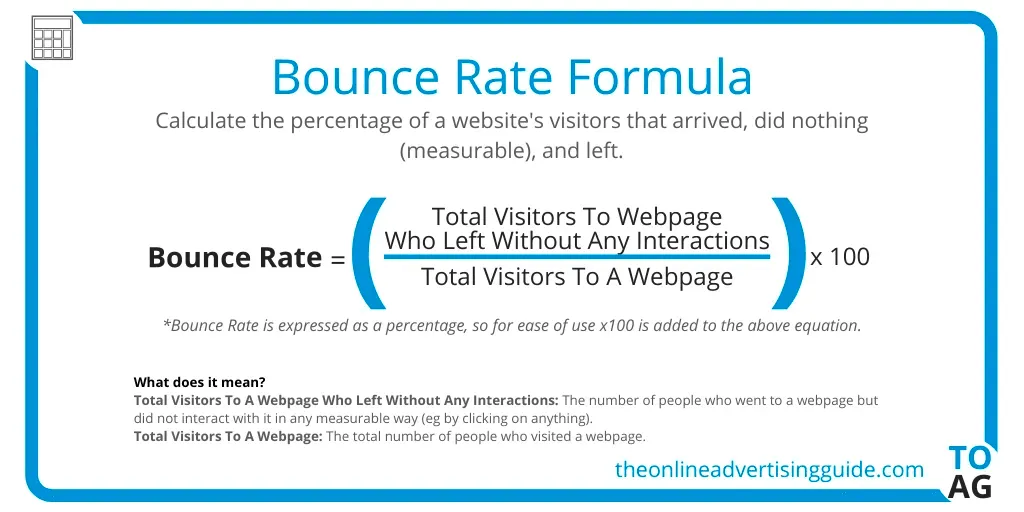
Source: The online advertising guide
Clearly, something's wrong if someone shows up, looks around, and immediately leaves. Of course, there'll always be some who do this. After all, some folks always find you by accident or realize that what you offer isn’t what they’re looking for. But measuring this metric is essential because if your bounce rate is abnormally high, you’re targeting the wrong audience, or there’s something in your content repelling ideal customers.
Bounce rates can be tracked using a free tool like Google Analytics. You can then use one of the session replay and heat map tools mentioned earlier to determine what these people do on your site. Look for instances of rage clicks and try to isolate the point where each bounce happens. You should start to see patterns.
Different factors can influence bounce rates. For example, if someone clicks on your blog post and doesn’t scroll past the first few paragraphs, you lose them in your intro. The messaging is ineffective if they’re watching your video and not acting.
If someone pops into the site and then pops right back out without taking action, either the site’s performance was too slow, they clicked by mistake, or something at the top of your page turned them away.
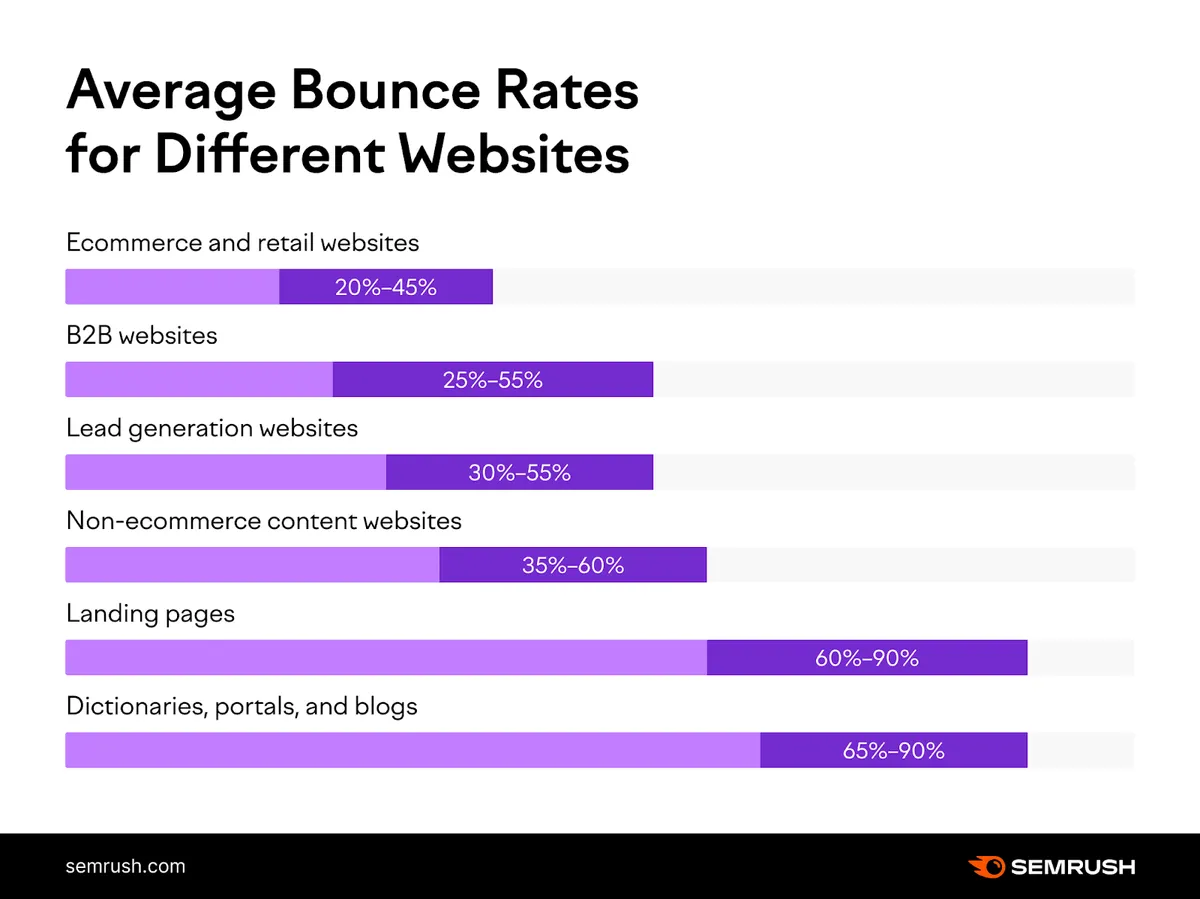
According to SEMRush, the average bounce rate falls between 26% and 70%, although this can vary based on your industry, as shown in the image above.
You can improve your bounce rate by monitoring each bounce closely, using the tools mentioned above to identify and correct issues. For example, if your site’s layout is too confusing, redesigning the homepage to appeal to your target audience can lower the bounce rate.
Website Traffic
Website traffic measures the number of people coming to your site, where they’re coming from, and the average time they spend there. Any content on outside platforms should draw people to your website. The website traffic KPI measures the effectiveness of that content.
Several services allow you to check your website traffic for free. For example, the SEMRush website and Neil Patel have free website traffic checkers.
If you see that a certain video or guest blog post isn’t bringing people over, ask yourself why. Additionally, if you have outside content pushing visitors in the door, what’s different about that?
Was it a different platform resonating better with your audience? Are they responding to video over text or vice versa? The answers to these questions lie in your website traffic KPI.
You can improve website traffic by learning from the data you’re gathering and making changes accordingly.
For example, if you notice that one lead source is paying off while another isn’t, allocate more of your budget toward the source seeing results. That will bring in more quality traffic.
Paid and Organic Outreach
When trying to push out content, there are two ways people can find you — organic reach and paid reach.
Organic reach shows the people who are finding you through organic searches. This is typically a Google search resulting from successful search engine optimization. Then you have your paid reach, which comes from pay-per-click ads like Google Ads, Facebook Ads, and other forms of paid advertising.
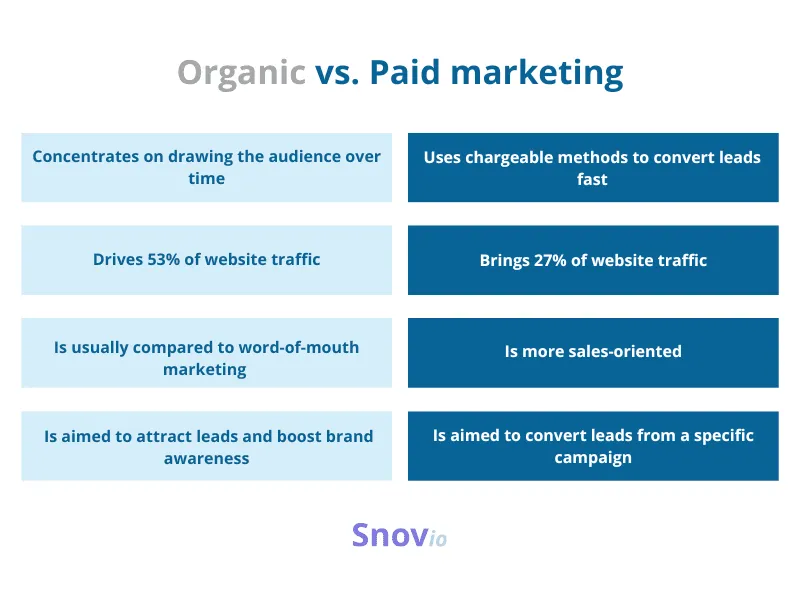
Source: Snov
Different factors determine these metrics. Ideally, you want to see organic outreach rise over time. SEO has tremendous potential for return if you can get onto the first page of the Google SERP. But that takes time and skill.
If you don’t see a tremendous return on the paid outreach KPI, there’s an issue with your targeting. Initially, you should see a higher return on your paid outreach with low levels of organic visitors. But then, as your SEO efforts start to take hold, you should see that organic number rise.
That’s why measuring this KPI is so vital. Your SEO and paid outreach are essential to continued profitability, which means if one or both falters, you’ll feel it in your wallet.
You can monitor both organic and paid outreach through Google Analytics by monitoring where website visitors and converting customers come from. Paid outreach can also be observed through platforms tailored to each lead source (NapoleonCat for social media, Google Ads dashboard for Google Ads, etc.)
Boost organic SEO metrics with an experienced SEO professional who understands Google’s algorithm. Paid outreach can be improved by examining your campaign results, seeing what messaging worked (or didn’t), and altering your targeting for maximum results.
Returning Visitors
As the name suggests, this metric shows what percentage of your audience has visited your site before.
This is crucial because your content marketing strategy should seek to generate new traffic and keep existing visitors coming back. It costs far less to retain someone than it does to bring in a new visitor. That’s why customer retention is the backbone of profitability.
Only by keeping track of repeat visitors (and repeat business if you’re using content to sell products) will you be able to understand the effectiveness of your content and how it’s contributing to your overall success.
Several factors can influence the returning visitors metric. When you’re regularly putting out content, whether a blog, social media posts, video blogs, or podcasts, you should be able to develop an audience that wants to consume your content regularly. If you’re not seeing many repeat visitors, you need to ask yourself where the problem lies.
Your content quality may be low. Someone may have been interested in your presentation but found your execution lacking. It could be that your site was running slow, and users navigated away.
You can track returning visitors in Google Analytics under the Audience tab. Just select Behaviors and then New vs. Returning Users.
Returning users should make up more than 30% of your traffic. If that number is too low, you’re not pulling people back. If it’s too high (over 50%-60%), you’re not drawing in enough new visitors.
Boost this metric by understanding what your audience wants to see and regularly publishing content to draw them back. For example, if posting blog articles on Thursdays brings in more returning visitors than a Friday post, shift your focus to Thursdays.
Conversion Rate
Few KPIs are more important than your conversion rate. And by conversion, we’re not just talking about monetary transactions.
Your conversions encompass any action you want to see an audience take. This can include newsletter sign-ups, ebook downloads, YouTube subscriptions, or any other measurable action contributing to the overall content marketing strategy.
Your content marketing goals should have many steps. Each step that moves you toward profitability is a conversion for that stage.
The various types of content you produce should have individual conversions attached. That’s why measuring them is so important — a temperature check lets you know how your content marketing plan performs.
For example, subscribing to a YouTube channel would be a conversion. Once that person subscribes, they move into the next phase of your sales funnel, where another conversion will ultimately push you closer to content marketing success.
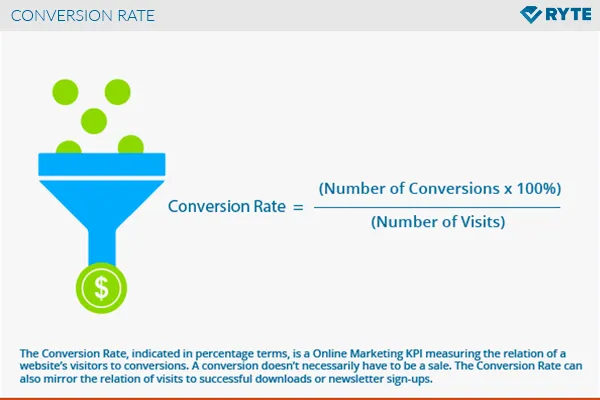
Source: Ryte
In the image above, you can see the formula for measuring this KPI. Take the conversions you’ve received and divide them by the total visits to your website. Multiply that answer by 100, and you’ve got your conversion rate.
Factors that influence conversion rates are varied. It could be an unclear call to action, website performance, unconvincing copy, or a poor layout. You can boost conversion rates by analyzing the existing metric, determining where people are dropping off, and making changes with your audience in mind.
For example, if your call to action isn’t generating conversions, perform A/B tests on some different options. This can be done using a tool like Optimizely, which presents both options to your audience to see which performs better.
Brand Awareness
Brand awareness is one of the most critical KPIs for content marketing. It measures the public perception of your brand, including whether people know it exists and what conversations surround it.
This is an essential metric because your ultimate goal should always be growth. Awareness lends itself to that growth. Your audience will grow as more people learn who you are. Once your brand name is tied to a certain quality, you’ll have a set amount of goodwill and trust from ideal customers. Pro-tip: Consider using a business name generator for name ideas that inspire trust and efficiency among your target audience.
You can check for the brand awareness KPI by monitoring mentions of your brand name across social media platforms, review sites, and any other industry-relevant platform. This can be done with a tool like Mention.
Brand awareness is a game of quality rather than quantity. If you’re getting a lot of negative mentions, that’s not good. But it can also help inform your content marketing campaigns going forward. Poor customer support interactions, user error, a confusing sales process, or a PR issue like a data breach can generate negative comments.
Improve your brand awareness by taking any negative mentions and learning from them. You can even respond to them productively to fix the issue and change public perception. If your brand isn’t being mentioned, try something new to get your name out three.
For example, try guest posting on a relevant blog or news site that'll share content for you. Reach out to the press and have them cover some of your charitable initiatives to get people talking about your brand.
Conclusion
To maximize content marketing ROI, you need to understand how your current content marketing strategies are performing. The only way to do that is by closely monitoring the KPIs listed above.
By watching these critical content marketing metrics, you’ll be able to maximize the impact of your content marketing plan and make adjustments that'll put you in the black for years to come.
Related blog posts

AI Overviews Are Taking Over SERPs
From traffic drops to decreasing CTRs, AI Overviews are shaking up SEO. Learn what is happening and how AccuRanker helps you track AIO.
25 June 2025
How AccuRanker’s AI Models Fix Inaccurate SEO Data
Struggling with unreliable SEO data? Discover how AccuRanker’s CTR, Search Intent, Search Volume, and Share of Voice deliver accurate insights.
1 June 2025
Why Your CTR Model Is Betraying You
The static CTR model relies on outdated averages. Learn more about how AccuRanker's dynamic CTR model helps you prioritize your SEO efforts.
13 May 2025



